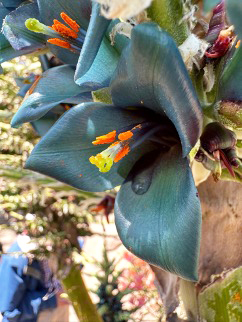
Garden Director Lew Feldman
Unlike pollen, which is released by the flower only once, nectar is a renewable resource, often replaced daily, especially in long-lived flowers such as puyas. It is unusually sweet, a fact not lost on the Garden’s resident squirrels!
Nectar is the main floral reward for bees and birds, and while sweet it consists of more than sugars. A variety of non-sugar components, including amino acids and compounds known as “secondary metabolites” make up the nectar and play important roles in the nutrition and health of the pollinators who rely on this source for food.
Although nectar is often replaced daily, as the flower ages the nectar quality and quantity can change. The changes are often a consequence of either the visiting pollinators adding microbes, or as the weather changes. An appreciation of the chemical complexity of nectar was pioneered here at UC Berkeley, by former Garden Director Professor Herbert Baker, who in this work was often assisted by his wife, Irene.
Nectar volumes are reported to range from tiny amounts in many bee-pollinated flowers, to as much as an 1/8th of a teaspoon in flowers pollinated by birds or bats, and the sugar concentrations can range from 10 to 70% of the volume of the nectar.
Because of its sugar content, nectar is a rich medium for microbial growth and colonization by yeast and bacteria, which as a result can change nectar composition. And while most microbes may deplete particular compounds in nectars, others may add compounds including ethanol produced by yeast fermentation and consumed by tree shrews in the Malaysian rainforests.
Amino acids are also found in nectar but occur at far lower concentrations than sugars. The functional significance of the amino acids for the health of pollinators is not clear, but is probably small for most pollinator groups. Most intriguing, however, are reports that some nectar components can influence the foraging behavior of pollinators. For example, high levels of potassium found in some nectars appear to discourage pollination by honeybees. In other nectars some secondary metabolites, such as caffeine, have been shown to be highly attractive to bees, altering bee behavior by drawing more bees to flowers than can be supported by the amount of nectar produced. And while this might benefit the plant, it is hard to see how this alteration in its behavior benefits the bees. A likely more positive role for secondary metabolites is in the protection they can offer pollinators from parasites and other pathogens, but the mechanisms underlying this protection need further study.
Finally, it is worth noting that plant breeding can, and has, led to changes in nectar traits, making a plant more, or less, desirable to pollinators.
For further readings: Susan W. Nicolson, 2021. “Sweet solutions: chemistry and quality”. Philosophical Transactions Royal Soc. B, 377.
